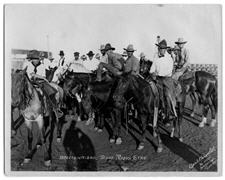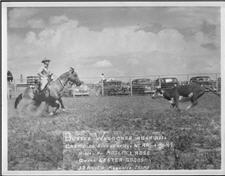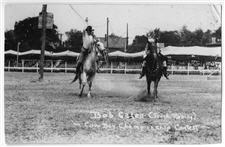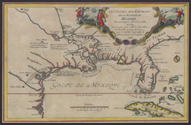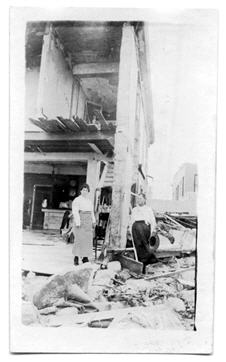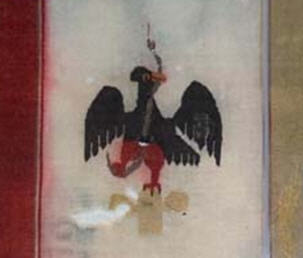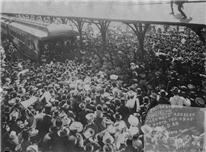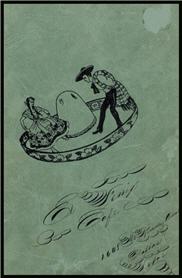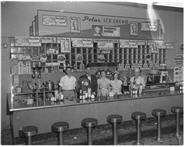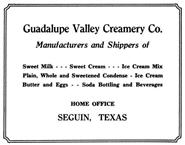The e-newsletter of UNT's Portal to Texas History| August 2008
Content
New Collections
What's in the lab now?
Focus on . . .Rodeo Pictures!
Making a Difference with Students
NEH honor: EDSITEment
A talk with historian Stuart Reid
TDNP: a new grant
UNT Digital Collections
![]()
Legacies: a History Journal for Dallas and North Central Texas
Legacies is a biannual publication devoted to the rich history of Dallas and North Central Texas as a way to examine the many local historical legacies—social , ethnic, cultural, political—which have shaped the modern city of Dallas and the region around it. Currently,  Legacies is a joint publication of Dallas Heritage Village, the Dallas Historical Society, the Old Red Museum, and the Sixth Floor Museum at Dealey Plaza. This new collection to the Portal gives our visitors access to 38 issues of this brilliant history journal featuring the spring 1989 through fall 2007 issues.
Legacies is a joint publication of Dallas Heritage Village, the Dallas Historical Society, the Old Red Museum, and the Sixth Floor Museum at Dealey Plaza. This new collection to the Portal gives our visitors access to 38 issues of this brilliant history journal featuring the spring 1989 through fall 2007 issues.
Each issue, comprised of 40 – 70 pages, has its own “focus”. Examples of these include: Architecture in Dallas, Newspapers and Radio in Dallas, Theater in Dallas, George Bannerman Dealey, Dallas in the 1960s, Women Who Made a Difference, Dallas Lost & Found: Hidden Treasures and Forgotten Stories , Dallas Pioneers, and the assassination of President John F. Kennedy. Inside each issue the reader will find historic photos and maps, remarkable stories and book reviews. The Portal includes each issue in its entirety, which can be viewed with our page-turning feature.
Shown are two issues’ covers; One from fall 2006 focusing on the assassination of JFK, and the other with the iconic Dallas Pegasus, from fall 1999 focusing on triumph over adversity.
José L. Castillo Photograph Collection
The Portal to Texas History and the UNT Archives have added 1104 photographic images by José L. Castillo, a Katie award-winning correspondent for the international EFE News Service. This archive of photographs, taken between July 2004 and July 2006, was donated to the UNT Archives in March 2007. It is the first entirely digital photo collection in the UNT Archives.
photographic images by José L. Castillo, a Katie award-winning correspondent for the international EFE News Service. This archive of photographs, taken between July 2004 and July 2006, was donated to the UNT Archives in March 2007. It is the first entirely digital photo collection in the UNT Archives.
These splendid, colorful images depict events in the Latino community, including: the 350,000-strong march against the HR4437 immigration bill in Dallas in April 2006, Hispanic community and political leaders, festivals, Latino soccer leagues and other gatherings in the North Texas area. Featured subjects include: Fort Worth Mayor Mike Moncrief, former Dallas Mayor Laura Miller, Dallas ISD Superintendent Michael Hinojosa and former LULAC President Hector Flores.
The Images in this article show Hector Flores, the Dallas Farmers Market, and the Mega March on April 9, 2006 in Dallas. When the project is completed, over 3,000 images from Castillo will be online at the Portal.
Clarendon, a small town in the Texas panhandle, recently received a big historical boost. The Portal team recently uploaded thirteen historical ledgers that document the development and history of the town from 1901 to 2003. The ledgers contain pages with handwritten text, typewritten text, newspaper clippings and pages printed from electronic documents. The types of information contained in them cover:
- minutes from Clarendon Town Council meetings
- minutes from Clarendon City Commissioners meetings
- minutes from Clarendon Chamber of Commerce Board of Directors meetings
- ordinances proposed and passed by the City of Clarendon
- papers for the incorporation of the Town of Clarendon
- documentation filed in the Office of the County Court for Donley County
Some interesting tidbits found in these ledgers include an application to open a telephone exchange and electric power plant in Clarendon in 1902; a citizen asking the Chamber of Commerce to help the city’s baseball team hire a “pitcher who is able to deliver the goods…and pay him real money… to get a crowd out to the games” in July 1920; City of Clarendon meetings about telephone rates, carnivals located within 200 feet of residences, the establishment of a “Permanent Fireman”, and improvements for the band in the summer of 1938; in 1941 the city decided to stop furnishing free water to the school and began to charge them the regular domestic rate of $1.00 for the first 2000 gallons; the creation of the city dog pound in 1964; in 1984 there were proclamations for things such as Child Support Month, Social Security Week, Alzheimer’s Awareness Month, etc.; a trash truck was approved for purchase in 1998 for $61,463,00. Recycling was discussed at length during the 1990’s and a Recycling Center was opened in Nov 2001.

Lockheed Martin

The folks at Lockheed Martin Aeronautics Company, Fort Worth, are collaborating with us to provide access to photographs from their extensive image archives of the Mile Long Hangar, formerly operated by Consolidated  Aircraft Corporation. Thousands of hard-working women contributed to the war effort by building B-24 Liberators. Fort Worth's own "Rosie the Riveters" did their part to make the B-24 the most produced U.S. military plane in history, with over 3,000 manufactured in Fort Worth alone. On the right is an image of Charles Lindbergh touring the Mile Long Hangar in 1942, and above are images of women working in the aviation factory.
Aircraft Corporation. Thousands of hard-working women contributed to the war effort by building B-24 Liberators. Fort Worth's own "Rosie the Riveters" did their part to make the B-24 the most produced U.S. military plane in history, with over 3,000 manufactured in Fort Worth alone. On the right is an image of Charles Lindbergh touring the Mile Long Hangar in 1942, and above are images of women working in the aviation factory.
Cattle Raisers Museum
While the Cattle Raisers Museum awaits the completion of its new home at the 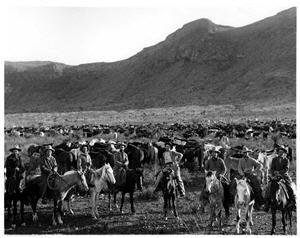 Fort Worth Museum of Science and History, we've partnered with them to digitize their extensive photographic archive which details the importance and significance of Texas and the Southwest's rich ranching heritage. Many of these photographs were first published in The Cattleman, the monthly magazine of the Cattle Raisers Association. This image features Jim Stroud and seven cowboys who worked the trails between Lajitas, Marfa, and Alpine around 1916.
Fort Worth Museum of Science and History, we've partnered with them to digitize their extensive photographic archive which details the importance and significance of Texas and the Southwest's rich ranching heritage. Many of these photographs were first published in The Cattleman, the monthly magazine of the Cattle Raisers Association. This image features Jim Stroud and seven cowboys who worked the trails between Lajitas, Marfa, and Alpine around 1916.
Amon Carter Museum
 The Amon Carter Museum has partnered with us to provide access to rare books and pamphlets that detail Fort Worth's rich history. Pictured at right is a photo and caricature of Amon Carter from Makers of Fort Worth (1914). Other materials in the works include a volume of the Panther City Parrot from 1906 (Polytechnic College); Fort Worth, the "Convention City" and a City of Beautiful Homes (1921); The Book of Fort Worth (1914); the official souvenir magazine of the 36th annual convention of the Cattle Raisers Association; The Stock manual: containing the name, post office address, ranch location, marks and brands of all the principal stockmen of western and northwestern Texas, showing marks and brands on electrotype cuts as they appear on the animal (1881); and other fascinating materials. All of these projects mentioned above are funded by the Amon Carter Foundation and the Adeline and George McQueen Foundation..
The Amon Carter Museum has partnered with us to provide access to rare books and pamphlets that detail Fort Worth's rich history. Pictured at right is a photo and caricature of Amon Carter from Makers of Fort Worth (1914). Other materials in the works include a volume of the Panther City Parrot from 1906 (Polytechnic College); Fort Worth, the "Convention City" and a City of Beautiful Homes (1921); The Book of Fort Worth (1914); the official souvenir magazine of the 36th annual convention of the Cattle Raisers Association; The Stock manual: containing the name, post office address, ranch location, marks and brands of all the principal stockmen of western and northwestern Texas, showing marks and brands on electrotype cuts as they appear on the animal (1881); and other fascinating materials. All of these projects mentioned above are funded by the Amon Carter Foundation and the Adeline and George McQueen Foundation..
|
What could be more "Texas" than a rodeo? Come on partner, and take a look.
|
Meet Hannah Tarver! Hannah is a graduate student who is finishing her degree this month. Hannah’s hometown is Chandler, Arizona.
Hannah is getting her master’s degree in Library and Information Science with an emphasis in Information Organization at UNT. “I have had really awesome  professors here at UNT, and my time with Digital Projects has been great,” said Hannah.
professors here at UNT, and my time with Digital Projects has been great,” said Hannah.
When asked what she learned working in the Digital Projects Unit, Hannah said, “I think one of the best parts of working in Digital Projects Unit for me has been that I’ve gotten to apply a lot of what I have learned in my cataloging classes to my metadata records, but I’ve also gotten a much broader view of the theory behind cataloging and how all of the traditional methods can or cannot be applied to the Internet and to different media than libraries have historically dealt with.”
“Also, I’ve gotten to do what is essentially original cataloging on items far more complicated to catalog that what I would likely see in a library, so I’ve been challenged in ways that will make other cataloging relatively easy,” added Hannah.
“In terms of graduation, I think the broader perspective has really given a different angle in my class work. I have brought up my work in Digital Projects and the way that Portal to Texas History records are handled as examples in several of my classes and even cited them in papers as examples of non-traditional cataloging. Of course, it’s given me the sort of experience that’s hard to get, but a huge bonus in my field, particularly now that so many institutions are trying to find ways to incorporate digitization.”
Hannah has been an integral part of the Digital Projects Unit since August of 2007. All of the Portal to Texas History staff wish Hannah a big Congratulations on all of her accomplishments while here at UNT.
The National Endowment for the Humanities (NEH) honored the Portal to Texas History this summer by selecting us for inclusion on their website EDSITEment as one of the best online resources for education in the
 humanities. Michael Hall with NEH said, "The Portal to Texas History was nominated for inclusion in the EDSITEment project in response to an open call for nominations posted on our website and on several humanities listservs. Your site was then reviewed by a Peer Review panel composed of teachers and leaders in education and non-profit organizations. Panelists determined that your site met the EDSITEment criteria for intellectual quality, content, design, and most importantly, classroom impact."
humanities. Michael Hall with NEH said, "The Portal to Texas History was nominated for inclusion in the EDSITEment project in response to an open call for nominations posted on our website and on several humanities listservs. Your site was then reviewed by a Peer Review panel composed of teachers and leaders in education and non-profit organizations. Panelists determined that your site met the EDSITEment criteria for intellectual quality, content, design, and most importantly, classroom impact."
The panelists who reviewed the Portal website had great things to say about us:
- "The digital reproductions of photos and primary documents on this site provide visitors of all levels with a rich experience."
- "It does provide students with access to authentic and significant materials with precise references and clear content."
- "This site is user-friendly and attractive graphically."
We're really proud to be honored by NEH by their inclusion in EDSITEment, and look forward to making an impact in classrooms for years to come.

Stuart Reid spoke with us recently about the role the Portal to Texas History played for him while he was writing his award winning book, The Secret War for Texas. Stewart Reid was a historical consultant to the National Trust for Scotland for the Culloden Moor Memorial Project. He has been a librarian, a boatman, a professional soldier, a cartographer, and a surveyor, among other things. He has written twelve entries for the Oxford Dictionary of National Biography and is the author of fourteen previous books. He lives in the United Kingdom.
What was your inspiration for writing The Secret War for Texas? It was simple curiosity. I am primarily a military historian specializing in the 18th century, but quite by chance I discovered a cryptic reference to my 3 x great grandfather, Dr James Grant, having been killed or murdered in Mexico. Rather to my surprise I then very soon found that he had been a pivotal figure in the Texas Revolution, and was blamed for all the disasters arising out of the Matamoros expedition, from the collapse of the provisional government to the fall of the Alamo. Yet astonishingly little had been written about him – and most of that was wildly inaccurate - despite what turned out to be some very rich source material.
What are the challenges in writing a Texas history book while living in Scotland? Well actually it had its advantages, first because I had access to family information on Dr. Grant not available in Texas, and secondly because I had access to documents in the India Office, relating to his service with the East India Company, and to the (British) National Archives at Kew, where I was able to work through confidential papers relating to Mexico – and Texas as part of Mexico. The challenges, obviously, were at the Texas end. Thanks to the Portal I was able to access specific documents.
How did the materials in the Portal to Texas History help you when doing your research? Ultimately it’s the straightforward matter of being able to access original documents and transcripts rather than relying on re-hashing secondary sources which almost invariably do little more than perpetuate old errors of fact and interpretation.
Did you find anything surprising or revelatory in the Portal? There’s probably nothing specific I can point a finger to, other than to stress again what a different picture you get when you jettison secondary sources and everything else you’ve ever been told and then work from the ground up using the original materials. Any work of this kind always has its moment; not always as spectacular as finding the reference in a letter warning of a British agent, a “Doctor Somebody” who could only have been James Grant; which had me yell “Gotcha!” in the National Archives reading room, but there’s always that sense of connection at first hand with the real people we think of as history.
The Portal team and our partners at the Center for American History at UT have received a new grant for digitizing "Early Texas Newspapers - 1829-1861," a comprehensive grant to microfilm, digitize, and provide free public access to the earliest Texas newspapers held by the Center for American History. The Texas State Library and Archives Commission awarded $24,637 for the project, which will begin in September and finish in August of 2009.
The scope of the project includes sixty-one newspaper titles, and a total of 12,280 newspaper pages. A partial representative list of selected titles includes: The Texas Gazette (San Felipe de Austin), 1829-30, 60 pages; Telegraph & Texas Register (Houston), 1835-1845, 2,137 pages; Texas Republican (Brazoria), 1834-36, 127 pages; Galvestonian, 1839, 4 pages; Matagorda Bulletin, 1827-39, 128 pages; Redlander (San Augustine), 1841-1846, 140 pages; Southwestern American (Austin), 1849-53, 488 pages; Centinela (Brownsville, in Spanish), 1849, 4 pages; Texas Presbyterian (Victoria), 1846-48, 38 pages; Galveston News, 1848-1861, 112 pages; and Texas National Register (Washington), 1844-46, 88 pages.
Due to Texas’s frontier nature, business uncertainties, and the volatility of the political situation with Spain and Mexico, no newspapers survived long in Texas up to the time of the Texas revolt against Mexico. Nine publishers printed newspapers between 1819 and 1836, but only the Telegraph and Texas Register was still in publication at the time of the Texas Revolution. The Telegraph and Texas Register became the paper of record for the Republic of Texas, and played a major role in keeping citizens informed. Five years after Texas became a state in 1845, the number of newspapers had grown to thirty-six. The collection of newspapers proposed for microfilming and digitization provide critical information regarding the early history of Texas, both as a republic and a state.
The FCC Record
Last year , the UNT Government Documents Department collaborated
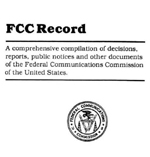 with the Digital Projects Unit to provide access to the Federal Communications Commission (FCC) Record, comprising 620 volumes and over 364,500 pages of searchable text. The FCC Record is a comprehensive compilation of decisions, reports, public notices, and other documents of the FCC from 1986 to the present.
with the Digital Projects Unit to provide access to the Federal Communications Commission (FCC) Record, comprising 620 volumes and over 364,500 pages of searchable text. The FCC Record is a comprehensive compilation of decisions, reports, public notices, and other documents of the FCC from 1986 to the present.
Several volumes document the FCC's many actions against "shock jock" Howard Stern during the 1990s. Now UNT is the only place in the world where researchers can search the full text of these important documents.
Help us spread the word and please forward this newsletter to anyone you think will be interested.
|
By the end of the year, the Portal will have over 600 yearbooks online. Check out the Hardin-Simmons University yearbook, the Bronco, from 1908-2007. Search for famous HSU alumni such as Dan Blocker, "Hoss" of Bonanza fame; Stedman Graham, Oprah's long-time boyfriend; and poker legend Doyle "Texas Dolly" Brunson. |
Making a global impact People love Texas history. Did you know that in July people viewed 1,477,385 pages on the Portal to Texas History? We're not only popular in Texas, but in Virginia, California, Georgia, New York, Ohio, and the rest of the world, too. You can help us create lasting access to history. Every gift makes a difference and is a solid investment in preserving Texas history. Wish List |
Image of the month As we head into hurricane season, we present this photo from the Corpus Christi hurricane of 1919 that shows damage to the Seaside hotel. This image is from the collections of our partners at the Corpus Christi Museum of Science and History. |
| Mission
Statement The Portal to Texas History offers students and lifetime learners a digital gateway to the rich collections held in Texas libraries, museums, archives, historical societies and private collections. The Portal team at the University of North Texas provides leadership by supporting collaborative efforts with its partners, while pursuing the goals of accessibility, best practices, and preservation of historical material. |
Fun Tip # 273 If you see an image you like in this newsletter, just click on it to go see the original on the Portal to Texas History - it's that easy! |
Sign up for the Portal to Texas e-Newsletter! Please forward this newsletter to friends, family, or anyone else who loves Texas history! If you'd like to sign up for our newsletter, just click the link above and send the email. Please feel free to reprint any article you find here in your own publications - we want everyone to know about us, our partners, and the wonderful work we are doing! There's no need to ask for special permission, just reprint an article and state "Reprinted with permission from the Portal to Texas History's Beyond the Bytes newsletter." |
|
Take a look at our newest Primary Source Adventure on the Battle of San Jacinto You can learns lots of fascinating things in our educational resources. Do you know: who performed the first surgery in Texas? how it feels to charge into battle? the Commanche word for fire? what region of Texas had the most slaves? when to walk away, and when to run? |
It's Online!! Historic photos from UTA documenting Fort Worth history are up. This photograph is of Teddy Roosevelt's visit to Fort Worth in April 1905. Also online are new images from Beth-El Congregation Archives in Fort Worth. Below are Bishop Cassata and Rabbi Robert Schur. |
Who knew? you can find anything on the A search for "ice cream" finds 155 results. Here are a few. Gate City Creamery Fair Exhibit, 1936, Childress County Heritage Museum El Fenix Cafe menu listing 10¢ ice cream, Denton Public Library Polar Ice Cream in Austin, 1954, Austin History Center Advertisement for the Guadalupe Valley Creamery Co. from Jahrbuch der Neu-Braunfelser Zeitung fuer 1943, UT Arlington An ice cream social at the First Methodist Church in Texas City around 1909, Moore Memorial Public Library |
Contact
Us
Beyond the Bytes is a free electronic newsletter emailed every month to subscribers of PortaltoTexasHistory@unt.edu listserv. Dreanna Belden,
Editor: Ann Howington, Contributor Emily Hart, Contributor To unsubscribe from Beyond the Bytes: click here UNT Libraries
|




